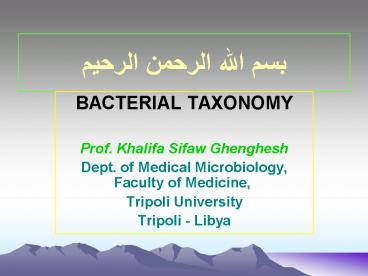BACTERIAL TAXONOMY - PowerPoint PPT Presentation
1 / 26
Title: BACTERIAL TAXONOMY
1
??? ???? ?????? ??????
- BACTERIAL TAXONOMY
- Prof. Khalifa Sifaw Ghenghesh
- Dept. of Medical Microbiology, Faculty of
Medicine, - Tripoli University
- Tripoli - Libya
2
Carolus Linnaeus (17071778)
- Swedish botanist credited with founding the
science of taxonomy. - He introduced the binomial system of nomenclature
- Linnaeus also established a hierarchy of
taxonomic ranks species, genus, family, order,
class, phylum or division, and kingdom. - At the highest level, Linnaeus divided all living
things into two kingdomsplant and animal. - In his taxonomic hierarchy each organism is
assigned a species name, and species of very
similar organisms are grouped into agenus and so
on.
3
Taxonomy
- The science of classification and refers to
- Classification
- Nomenclature and
- Identification
4
A Comparison of the More Notable Classification
Systems of Living Organisms
- Haeckel (1894) Whittaker (1959) Woese
(1977) Woese (1990) - Three kingdoms Five kingdoms Six kingdoms
Three domains - -------------------------------------------------
--------------------------------------------------
------ - Protista Monera Eubacteria Bacteria
- Plantae Protista Archaebacteria Archaea
- Animalia Fungi Protista Eukarya Plantae
Fungi - Animalia Plantae
- Animalia
5
The Phylogenetic Tree of Life based on
Comparative ssrRNA Sequencing.
the nucleotide sequences of the small subunit
ribosomal RNA.
6
(No Transcript)
7
Classification
8
- The systematic division of organisms into related
taxa (groups) based on similar characteristics
9
1. Conventional ClassificationMajor
characteristics used in conventional
classification
Feature
- Cell shape
- Cell size
- Colonial morphology
- Ultrastructural characteristics
- Staining behaviour
- Mechanism of motility
- Cellular inclusions
- Carbon nitrogen sources
- Cell wall constituents
- Energy sources
- Fermentation products
- Growth temperature optimum range
- Osmotic tolerance
- Oxygen relationships
- pH optimum growth range
- Sensitivity to metabolic inhibitors antibiotics
10
2. Adansonian or Numerical Classification
- Numerical taxonomy, the use of computers.
- A large number of biochemical, morphological and
cultural chara-cteristics are used to determine
the degree of similarity between organisms
(similarity matris) and conversion to dendogram
(phenogram)
11
OTU operational taxonomic unit
12
3. Phylogenetic Classification
- An evolutionary arrangement of species.
- Sharing a recent ancestor as in plants and
animals (fossil records) - In bacteria?
- Possible by Molecular Methods
- Genetic Homology
- Base composition (GC ratio)
- Nucleic acid hybridisation.
- Ribosomal RNA (rRNA) sequence analysis
- Protein profiles and amino acid sequences
13
- PURE CULTURE
- Populations of individuals all derived from the
same single organism. - STRAIN
- A Group of Pure Cultures Derived from a Common
Source and Thought to be the Same. - SPECIES
- A Group of Closely Similar Strains.
14
INTRASPECIES CLASSIFICATION
- Biotypes
- Biochemical properties.
- Serotypes
- Antigenic features.
- Phage Types
- Bacteriophage susceptibility.
- Colicin Types
- Production of bacteriocins.
15
Nomenclature
16
- Naming of microorganisms.
- Governed by international rules
- Rules published in the International Code of
Nomenclature of Bacteria. - The International Journal of Systematic
Bacteriology
17
Rules for the Nomenclature of Microorganisms
- There is only one correct name for an organism.
- Names that cause error or confusion should be
rejected. - All names in Latin or are latinized.
- The first word (genus) is always capitalized.
- The second word (species or specific epithet) is
not capitalized. - Both genus and species name, together referred to
as species, are either underlined or italicized
when appearing in print. - The correct name of a species or higher taxonomic
designations is determined by valid publication,
legitimacy of the name with regard to the rules
of nomenclature, and priority of publication.
18
Nomenclature
- Casual or Common Name
- e.g. "typhoid bacillus"
- Scientific or International Name
- Salmonella typhi
- Salmonella london
- Staphylococcus aureus
- Clostridium tetani
- Mycobacterium bovis
- Borrelia burgdorferi
19
Identification
20
- Biologists often use a taxonomic key to identify
organisms according to their characteristics. - Dichotomous key
- most commonly used in identification.
- has paired statements describing characteristics
of organisms.
21
Methods used for Identification of Bacteria
- Cellular morphology
- Staining characteristics
- Motility
- Growth characteristics
- Biochemical characteristics
- Serological tests
- Analysis of metabolic end products or structural
components of organisms by different methods
(e.g. GLC) - Genetic analysis using nucleic acid probes and
other molecular techniques (e.g. PCR)
22
(No Transcript)
23
- Dichotomous Key
24
Enterotube
25
- Bergey's Manual
- Methods for distinguishing and identifying
bacteria are assembled into Bergey's Manual of
Determinative Bacteriology - Bergey's Manual of Systematic Bacteriology
- Provides description of physical chemical
characteristics and system of identification of
medically important members of selected sections
of bacteria
26
Polyphasic Bacterial Taxonomy
- More data will become available, more bacteria
will be identified, there will be more
information, and software development will need
to address the combination and linking of the
different databases. - A polyphasic approach to bacterial classification
includes - Methods to phylogenetically allocate bacteria
- Methods to compare and group large numbers of
strains into clusters of similar bacteria - DNA-DNA hybridization to determine the
relationships between represnetativies withing
and between each of those clusters - And descriptive methods which will provide
further genotypic and phenotypic information.

